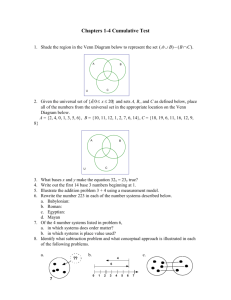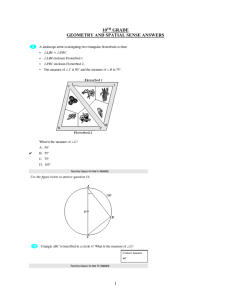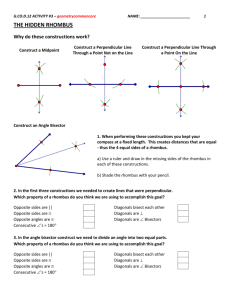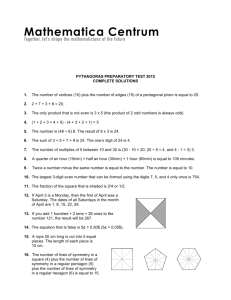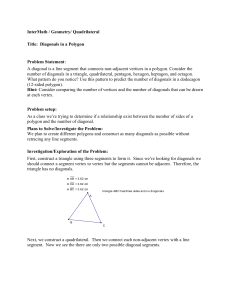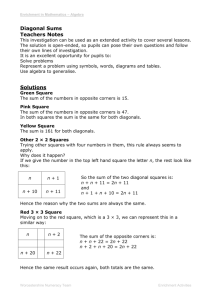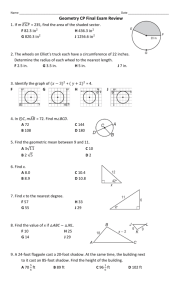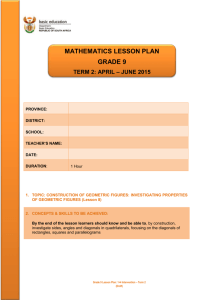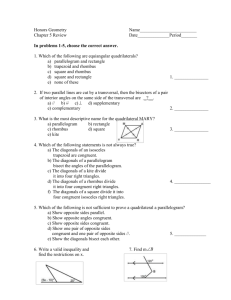P6 - CEMC
advertisement
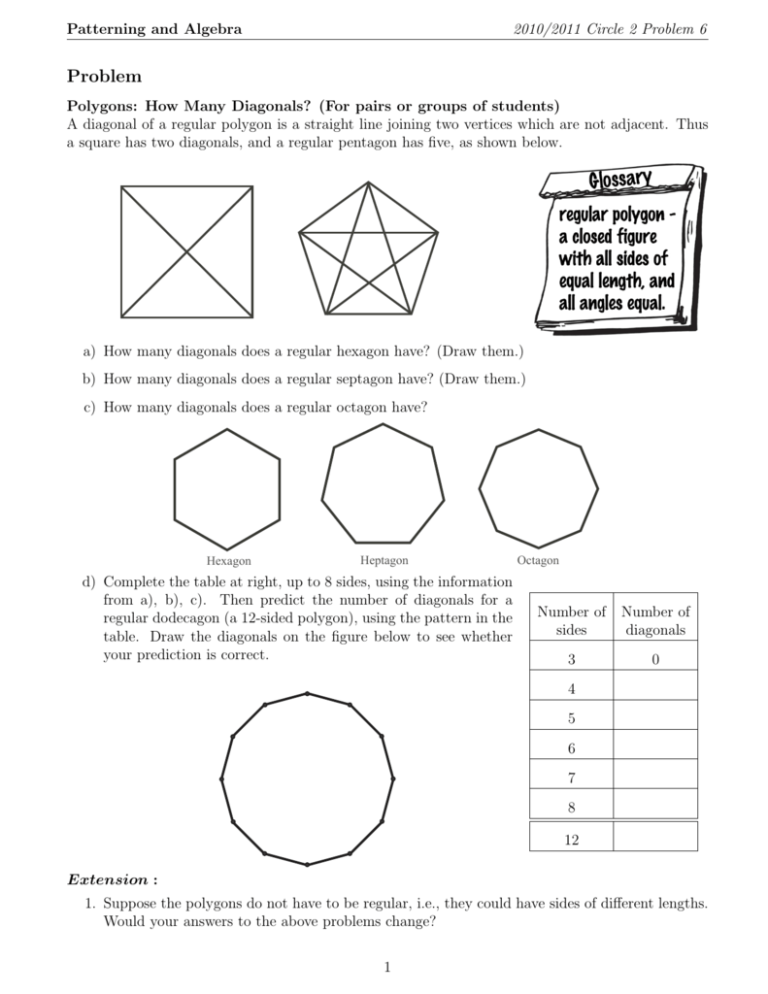
Patterning and Algebra 2010/2011 Circle 2 Problem 6 Problem Polygons: How Many Diagonals? (For pairs or groups of students) A diagonal of a regular polygon is a straight line joining two vertices which are not adjacent. Thus a square has two diagonals, and a regular pentagon has five, as shown below. a) How many diagonals does a regular hexagon have? (Draw them.) b) How many diagonals does a regular septagon have? (Draw them.) c) How many diagonals does a regular octagon have? Hexagon Heptagon d) Complete the table at right, up to 8 sides, using the information from a), b), c). Then predict the number of diagonals for a regular dodecagon (a 12-sided polygon), using the pattern in the table. Draw the diagonals on the figure below to see whether your prediction is correct. Octagon Number of sides Number of diagonals 3 0 4 5 6 7 8 12 Extension : 1. Suppose the polygons do not have to be regular, i.e., they could have sides of different lengths. Would your answers to the above problems change? 1 Patterning and Algebra 2010/2011 Circle 2 Problem 6 Hints Suggestions: This is a discovery activity which could be done by individual students or by small groups; if groups are used, assign one of the figures a), b) or c) to each group. Suggestions which may help are: 1. Have students use a different coloured crayon or pencil for the diagonals they draw from each vertex. This will help them to avoid counting a diagonal more than once. 2. Once students/groups have completed a), b), c), work with the class to complete the table in part d) up to 8 sides. 3. Trying to see a pattern requires some organized counting. To illustrate, sketch the diagonals of the octagon in stages with the students, on a large octagon on the board or an overhead, using the diagrams below as a guide. Note that, from vertex 1, we can draw 5 diagonals (red on the diagrams), since we can only use non-adjacent vertices. From vertex 2, we can draw 5 new and different diagonals (blue on the diagrams). But from vertex 3, we can only draw 4 new diagonals (black on the diagrams). At this point, ask students how many could be drawn from vertex 4 (3 new diagonals, shown as dashed red on the last diagram), then vertex 5 (2, as dashed blue), and vertex 6 (1, as dashed black). Thus the octagon has 5 + 5 + 4 + 3 + 2 + 1 = 20 unique diagonals. 1 2 1 8 3 2 7 4 6 5 Diagonals from Vertex 1 (5) 1 2 8 3 7 4 6 8 3 2 7 4 5 Diagonals from Vertex 1 and 2 (5+5) 1 6 5 Distinct Diagonals from Vertex 1, 2 and 3 (5+5+4) 8 7 3 4 6 5 Distinct Diagonals from all Vertices (5+5+4+3+2+1) 4. To start them thinking about a 12-sided polygon, ask ”How many diagonals could be drawn from the first vertex? The second vertex?” This should help them get started on finding the total number by adapting the method used above for the octagon. 2 Patterning and Algebra 2010/2011 Circle 2 Problem 6 Solution a), b), c) The hexagon has 3 + 3 + 2 + 1 = 9 diagonals; the septagon has 4 + 4 + 3 + 2 + 1 = 14 diagonals; and the octagon has 5 + 5 + 4 + 3 + 2 + 1 = 20 diagonals, as illustrated on the diagrams below. (See also the detailed discussion of the octagon in the Hints and Suggestions for Problem 6 above.) 1 1 1 2 2 6 2 7 8 3 3 3 7 6 5 6 4 4 4 Hexagon 5 5 Octagon Septagon d) Following the pattern established for the octagon, we see that the dodecagon will have 12−3 = 9 diagonals from each of the first two vertices (red and blue on diagrams below), 8 from vertex 3 (black on diagrams), 7 from vertex 4 (dashed red on last diagram), 6 from vertex 5 (dashed blue on last diagram), 5 from vertex 6 (dashed black on last diagram), etcetera, giving a total of 9 + 9 + 8 + 7 + 6 + 5 + 4 + 3 + 2 + 1 = 54 distinct diagonals. 2 1 12 2 11 3 4 10 5 9 6 8 7 Diagonals from Vertex 1 (9) 1 2 12 4 2 4 10 5 12 11 3 11 3 1 10 5 9 9 6 8 7 Distinct Diagonals from Vertex 1, 2 and 3 (9+9+8) 6 8 7 Diagonals from Vertex 1 and 2 (9+9) 1 12 11 3 4 10 5 9 6 8 7 Distinct Diagonals from Vertices 1, 2, 3, 4, 5, and 6 (9+9+8+7+6+5) Extension : 1. Since the irregular polygons have the same number of vertices, and the number of diagonals depends only on the number of vertices, not the lengths of the sides, the number of diagonals would be exactly the same for irregular polygons as for regular polygons with the same number of sides. 3
